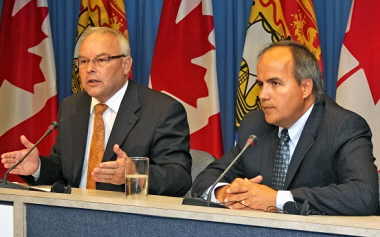New Brunswick wants mediation as delays confirmed
09 August 2010
The provincial government of New Brunswick has asked the Canadian federal government for mediation over cost overruns for the refurbishment of the Point Lepreau nuclear power station, after receiving confirmation that the project will not be completed before 2012.
 |
| NB energy minister Jack Keir (left) and NB Power president Gaëtan Thomas call for mediation (Image: Government of New Brunswick) |
According to New Brunswick energy minister Jack Keir, the provincial government is proposing that the issue of project delay costs for the refurbishment be put to a mediation process in order to determine a "fair outcome" for local ratepayers.
Point Lepreau is the first Candu 6 reactor to undergo major refurbishment, including replacement of all of its 380 fuel channels and associated feeder tubes. When the reactor was shut down for refurbishment in March 2008 the project was expected to take 18 months to complete and thus only cover one winter. However, the first-of-a-kind work has over-run, and general contractor Atomic Energy of Canada Ltd (AECL) subsequently pushed back the completion date to October 2010, then to February 2011. Now, according to NB Power president and CEO Gaëtan Thomas, AECL has confirmed that the refurbishment will take at least another year to complete, pushing the restart back to February 2012 at the earliest.
Over 90% of the AECL scope of the work on the project is at a fixed price, but Keir said that unless the federal government agrees that AECL must shoulder its share of the extra costs associated with the unanticipated delays, the extra financial burden will fall on the province's consumers. "New Brunswick ratepayers should not have to bear the burden of AECL's learning curve on re-tubing Candu 6 reactors," Keir said.
Although some retubing has been completed on earlier model Candu reactors, AECL has run into trouble at Point Lepreau with the tightness of seals between the new pressure tubes and calandria tubes. The company is removing roughness on some tube join surfaces as well as using metal inserts to reach the proper tightness.
AECL recently said that the work, which should extend the reactor's operating life by 25-30 years, was about 75% complete.
Researched and written
by World Nuclear News